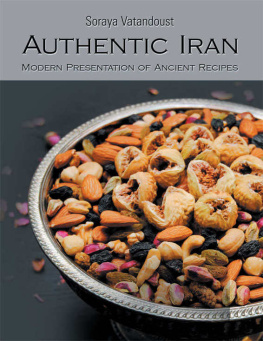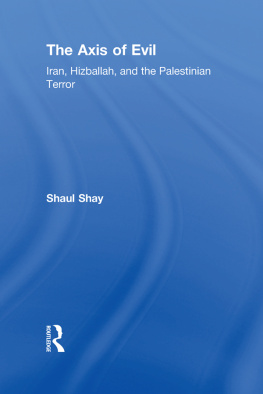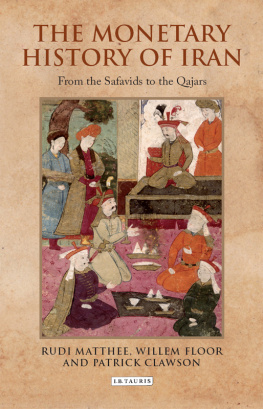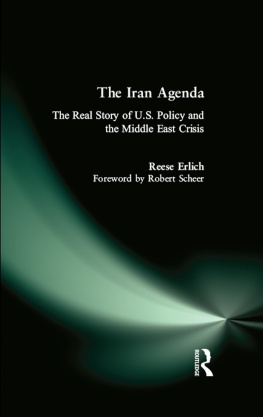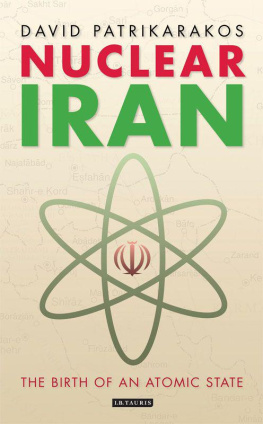
Authentic Iran
Author and photographer
Soraya Vatandoust

Copyright 2015 by Soraya Vatandoust 603419
Library of Congress Control Number: 2014919571
ISBN:
Softcover 978-1-4990-4060-9
Hardcover 978-1-4990-4059-3
EBook 978-1-4990-4061-6
All rights reserved. No part of this book may be reproduced or transmitted in any form or by any means, electronic or mechanical, including photocopying, recording, or by any information storage and retrieval system, without permission in writing from the copyright owner.
Rev. date: 03/10/2015
Xlibris
1-888-795-4274
www.Xlibris.com
Table of Contents

Jamal ad-Dn Ilys ibn-Ysuf ibn-Zakk or (Nezami-ye Gan javi)
(1141 to 1209) was born and is buried in Ganja (Modern day Azarbaijan)
Nezmi is considered the greatest romantic epic poet in Persian Literature, who brought a colloquial and realistic style to the Persian epic. Nezami is best known for his five long narrative poems, which have been preserved. Nezami was a master of the Masnavi style (double-rhymed verses). He wrote poetical works and the main one is the Panj Ganj (Five Jewels).
O You whose name is the finest beginning
Without your name when shall I open my speech
O You whose reminisce cherishes my reason
My tongue utters no other name but yours

Persian Rug
Demonstrating rug weaving process
This book would not have been possible without the sweetest person in my life my husband Ali Mummar. His constant love, encouragement, and support, kept me strong and motivated.
Loving thanks to my beloved sons, Hussain and Hadi, who light up my soul by keeping me busy, cheerful and young in spirit all the time.
I would like to thank my parents and siblings for their loving support and patience in always welcoming all my new recipes and food.
A very special thanks and wish of gratitude should be given to my lovely mother Hasna Vatandoust, who was my role model of cooking and baking with love and passion for my beloved ones.
A final thank you goes to my lovely niece and graphic designer, Zeynab Abdolghaffari, for generously contributing her beautiful photos of Iran to complete this book.

Nabat in Persian is referred to sugar crystals that are prepared and consumed vastly in Iran. Nabat is usually used to sweeten tea and other tasteless or bitter drinks prepared with flowers and herbs extract. Nabat is also prepared in very sophisticated designs to decorate wedding tables and Norooz tables.
In Iran sugar crystals has therapeutic usage too, it helps to bring comfort to the digestive system by reducing bloating, gases, and nausea, and stopping diarrhea.
Authentic Iran is a beautifully illustrated cookbook with dazzling images, that features an alluring selection of Persian recipes for different occasions, as well as presenting a quick introduction to Irans history and culture.
It is fantastic how love of food emboldens our generous nature of sharing, as food is all about sharing the good flavor while spending good time with those we love and that is how our beautiful memories are built. Cooking and baking for those we love gives us pride and satisfaction and brings joy and warmth to the household and the family. Cooking is an expression of devotion to those we love and it is all about spending time to put together delicious and nutritious meals to wrap up and complete a day of hard work.
My grandmothers, mother, aunts, and sisters were my first inspiration to become a good cook and feel affection for cooking and baking. In Iran, cooking is a tradition for each and every family that passes down from one generation to another. Cooking together and sharing recipes in cozy and crowded kitchen, where everyone in the family, have share in the daily food preparation. Holidays, parties, weddings and funerals, were always very stimulating and exhausting. Diving in my past memory, I recall a time when the family, couple of weeks ahead, gathered in our house and prepared food and sweets in large amounts. I always remember how my cousins and I used to garnish the deserts and shape the cookies.
Being the youngest sister, I used to be the kitchen helper who was responsible for shredding carrots, cleaning herbs, preparing salads, and many more easy chores. Later on my sisters got married and I was promoted to be the sous-chef of the house and gradually became in charge of baking cakes, cookies, and pastries for our afternoon tea. Those early days of baking, lots of travelling, sighting diversity of cultures, and cuisines developed my passion for cooking.
Although Iran has one of the most sophisticated cuisines in the world, but meals are less structured compared to any other western cuisine. As there are no appetizer, main, or dessert dishes to be served in a certain order or in personal portions. All different dishes are plated in large serving plates and brought to the table all at once where each person serves him/herself and decides what to eat first. Traditionally, food is served and consumed on a Sofreh instead of a table. (Sofreh is a beautiful and colorful rectangular piece of plastic or fabric that is placed over the rug on the ground and everyone sits around it).
Serving Persian food as described, brings joy and will be an exquisite experience, however, feel free to serve these dishes in your own way for lunch or dinner.
Persia or Iran?
The name Iran is the modern derivative of Aryana Land of Aryans. Aryan is referred to the first tribe who migrated from central Asia and was the first to settle on the Iranian Plateau. This tribe when settled in this region called it Eran or Aryana meaning the land of Aryans. Later on this one big tribe was divided to three smaller sects and were separated, the first sect migrated north west to Asia-minor (modern day Turkey). While the other two sects were the Aryan Medes who stayed in the central region of Iran, and the Aryan Parsians who migrated south toward the Persian Gulf and settled in the southern region of Iran.
The Aryan Medes were the first to unify the country, and by that it became one of the first empires in the 7 th century BC. Iran reached the pinnacle of its power during the Achaemind Empire founded by Cyrus the Great in 550 BC. The Achaeminds were from the Parsian sect of the Aryans, their empire grew and stretched to Europe, north Africa, west and central Asia, therefor historically Iran has been referred to as Persia by the western world due to the writings of the Greek historians who called Iran Persis meaning the land of Parsians.
In 1935 Reza Shah Pahlavi requested that the international community refer to the country as Iran. Opposition to the name change led to the reversal of the decision, and in 1959 both names Persia and Iran were to be used interchangeably.
Modern Iran is a large country of more than 600,000 square miles area, neighboring more than 10 countries and the second largest country in the middle east. It is made of high dessert plateaus and mountain ranges stretching in the north from east to west and along the western borders from north to south. This geographical diversity helped a lot with Irans distinct cuisine, based on the climate Iran is divided into four different regions. The warm and humid Caspian region, cold with lots of precipitation mountains on the west and north, very hot and dry desserts of the central region, and very hot and humid Persian Gulf region. An important advantage of this colossal difference in the climate is the growth of different crops, herbs, grains, legume, fruits and vegetation in each region, which created Irans three main cooking regions; northern, central and southern.
Next page
